
 |
|
| |||||||||||
|
Ratatouille - A Day at Pixar
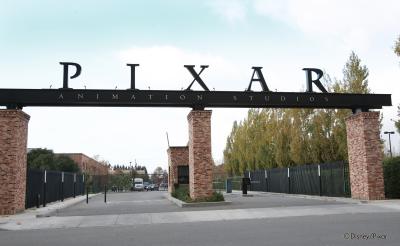
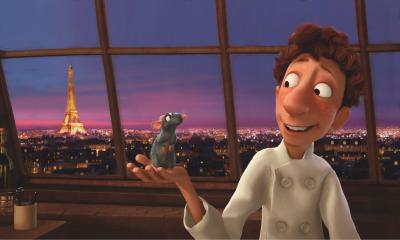 Our first stop was with Michael Venturini, a directing animator at Pixar who helped bring Remy to life. He started off the discussion by running through the animation tests throughout pre-production that gave him a feel for how these digital anthropomorphic critters ought to move and behave. "It was very similar to how we did Nemo in the sense that in this film, we had rats that were going to be talking and acting, but we still wanted them to be rats. Usually the first thing we'll do is very heavily reference rats, and we'll do a lot of animation tests that really explore rat behaviors." Remy is a rat, of course, but there's a very human quality to his character that has to be incorporated into the animation too, and striking that balance was a bit of a challenge. "We'll take a look at all of those tests we've done that are very realistic and pick little ideas out of them, and we'll try to sprinkle that into our acting. On Ratatouille, we went through a learning curve during production where we would do little sniffing and nose twitching behaviors that are very common when you watch rats, and we'd put that in our acting here and there. Brad [Bird] found that as he was editing the movie together, these things were popping up a little more often than he would like, so he started directing us to pull back a little bit from the 'rat-isms'." One of the other stumbling blocks Venturini and his team had to overcome was making a character with hands convincingly skitter around like a rat. "It was harder to get [Remy] on all fours because we built him with hands so he could cook. Getting his hands to behave like feet was actually harder than making his feet behave like hands." 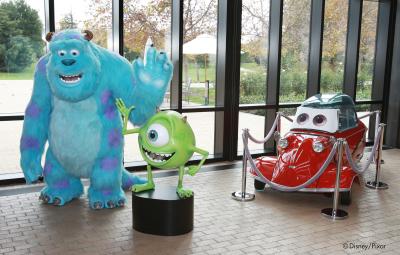 The CG model for Remy had been hammered out at Pixar before comedian Patton Oswalt had been cast to tackle his voice. "When we got the word that it might be Patton Oswalt, we pulled audio clips from some of his comedy routines and tried to do some test animation to his voice, " which Venturini and his team then put in front of the director to see if it felt like a solid fit. Even though the model for Remy had been constructed beforehand, some of Oswalt's vocal eccentricities did bleed into the character. "He does these little stutters and stammers in his voice, and Brad was very adamant in some of that coming through in the animation. It added to Remy's slightly nervous approach to some of the situations he was in. It kind of gives you a language, I guess, in the motion and his speaking patterns." 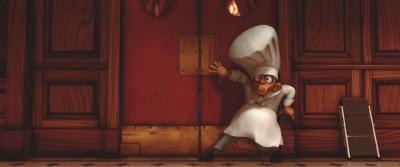
Next up, we got to chat with lighting director Sharon Calahan and production designer Harley Jessup, two of the key talents at Pixar that fleshed out the overall look of Ratatouille. One of their biggest challenges was bringing to life their own version of Paris. "The film I worked on before was Monsters, Inc., and it was wide open what a monster world would look like," said Jessup. "I really enjoyed designing around Paris; it's such a beautiful city. At the same time, we're not trying to mimic reality exactly. We're always caricaturing set design and trying to make a sculptural world that is extra-appealing. We tried to create a sort of fairy tale version of Paris."
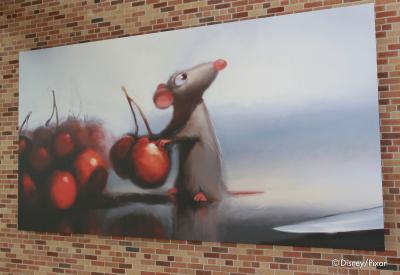 Part of that included exploring Paris not just from their perspective but Remy's as well. "We were crawling around on the streets...under stoves...all kinds of stuff, " Jessup said, noting that they were at times literally on their hands and knees. "We got a lot of funny looks while we were in Paris," Calahan continued. "'Why are they photographing their food?'" Then again, Jessup noted that all of that confusion was shrugged off the moment their accents were heard. "It's sort of freeing that there are so many tourists in that city that the Parisians think, 'Oh, they're only Americans.' They don't care." Capturing things from those different perspectives presented a bit of a challenge, as Jessup noted. "There were certain sets like the kitchen that we tried to make look A-plus anywhere you looked because we knew it was the main staging ground for Remy and the chefs. Normally we wouldn't design what's underneath the stove, but we did on [Ratatouille]. We would, with Brad, map out, say, the back courtyard -- wherever you'd be close up with the rats -- and those areas were shaded and modeled with more detail. I love the fact that you can't tell where those lines are, and [the shader group was] able to make the background cobblestones look as great as the close-up ones." The folks at Pixar was very conscious how the audience might react to seeing a rat putter around a kitchen. Jessup pointed out that "you may notice in the film, almost to a hilarious extent, that we have Remy washing his hands [before touching any food]." Calahan went on to note that "you'll notice that after the rats go through the dishwasher, they stay on their hind legs and don't touch anything with their front paws." Jessup mentioned that a lot of those subtle details might go unnoticed, "but we tried to make it possible for the audience to accept that and think that was funny rather than this...visceral disgust." 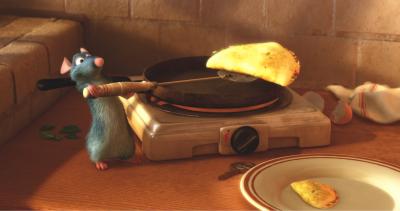
Calahan then delved into the effort that went into making Remy's gourmet cuisine look sumptuous and realistic on-screen. "It was definitely a challenge. It was something we knew was going to be early on, so we had quite a lot of time to work on it... However the animators wanted to chop something, the bits would kind of obey whatever the animators entered instead of constraining the animators into particular kinds of motions. It was pretty impressive." Bread and wine presented their own difficulties. "In the bread texture, it swirls as if someone's rolled the dough, and the uneven hole structure is from a particular kind of bread. It wasn't just any kind of random, generic bread. When we were doing wine, we were swirling and tasting, of course, and because it's Merlot in a glass, we wanted it to look like Merlot and not like a Shiraz."
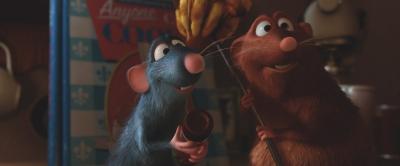
DVD Talk also got an advance peek at Your Friend, The Rat, the eleven minute short exclusive to the DVD and Blu-ray disc. Starring Remy and his brother Emile, the short is a smirking nod back to the low-rent educational flicks of the '60s. It's quite a bit different than the shorts we're used to seeing on Pixar's discs; clocking in just over eleven minutes, it's their longest one yet, and this one's not a quick narrative but a mini-documentary fat-packed with facts about rats. What really sets Your Friend, The Rat apart from Pixar's other shorts is its blend of many different forms of media, including hand-drawn 2D animation and stop motion.
 Disney and Pixar's Ratatouille arrives on DVD and Blu-ray on November 6th, 2007, and a full write-up of the DVD can be found in DVD Talk's review archive. Keep an eye out for a review of the Blu-ray disc in the next few days. Also Check out Our Other Coverage: Daniel Hirshleifer Reports from the Ratatouille media Day a DVD Talk Radio Interview with Brad Bird Many thanks go out to Mac McLean and a long, long list of folks at Pixar and Disney for putting this visit together and being such endlessly gracious hosts.
Archives
The 5 Most Influential Summer Blockbusters
Los Angeles Comic-Con Cosplay Spotlight Notes from Book Expo DVD Talk Interview: Batman: Return of the Caped Crusaders Compete Archives
Review Staff
| Newsletter Subscribe
| Join DVD Talk Forum
|
| |||||||||
| |||||||||||